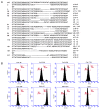Highly efficient generation of GGTA1 biallelic knockout inbred mini-pigs with TALENs
- PMID: 24358349
- PMCID: PMC3866186
- DOI: 10.1371/journal.pone.0084250
Highly efficient generation of GGTA1 biallelic knockout inbred mini-pigs with TALENs
Abstract
Inbred mini-pigs are ideal organ donors for future human xenotransplantations because of their clear genetic background, high homozygosity, and high inbreeding endurance. In this study, we chose fibroblast cells from a highly inbred pig line called Banna mini-pig inbred line (BMI) as donor nuclei for nuclear transfer, combining with transcription activator-like effector nucleases (TALENs) and successfully generated α-1,3-galactosyltransferase (GGTA1) gene biallelic knockout (KO) pigs. To validate the efficiency of TALEN vectors, in vitro-transcribed TALEN mRNAs were microinjected into one-cell stage parthenogenetically activated porcine embryos. The efficiency of indel mutations at the GGTA1-targeting loci was as high as 73.1% (19/26) among the parthenogenetic blastocysts. TALENs were co-transfected into porcine fetal fibroblasts of BMI with a plasmid containing neomycin gene. The targeting efficiency reached 89.5% (187/209) among the survived cell clones after a 10 d selection. More remarkably 27.8% (58/209) of colonies were biallelic KO. Five fibroblast cell lines with biallelic KO were chosen as nuclear donors for somatic cell nuclear transfer (SCNT). Three miniature piglets with biallelic mutations of the GGTA1 gene were achieved. Gal epitopes on the surface of cells from all the three biallelic KO piglets were completely absent. The fibroblasts from the GGTA1 null piglets were more resistant to lysis by pooled complement-preserved normal human serum than those from wild-type pigs. These results indicate that a combination of TALENs technology with SCNT can generate biallelic KO pigs directly with high efficiency. The GGTA1 null piglets with inbred features created in this study can provide a new organ source for xenotransplantation research.
Conflict of interest statement
Figures



References
-
- Kolber-Simonds D, Lai LL, Watt SR, Denaro M, Arn S et al. (2004) Production of alpha-1,3-galactosyltransferase null pigs by means of nuclear transfer with fibroblasts bearing loss of heterozygosity mutations. Proc Natl Acad Sci U S A 101: 7335-7340. doi:10.1073/pnas.0307819101. PubMed: 15123792. - DOI - PMC - PubMed
Publication types
MeSH terms
Substances
LinkOut - more resources
Full Text Sources
Other Literature Sources
Research Materials

